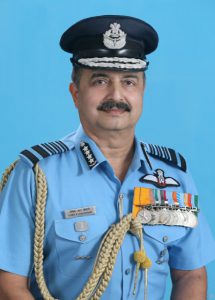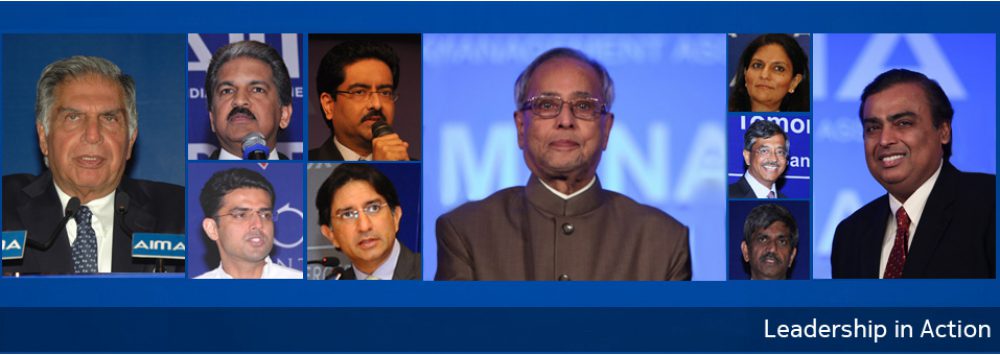
Air Chief Marshal Vivek Ram Chaudhari addressing
A potent Indian Air Force in the future will be characterized by an efficient network of sensors, decision-makers, and shooters coupled with firm leadership, advanced ammunition, and modern technology.
Air Chief Marshal Vivek Ram Chaudhari, PVSM, AVSM, VM, ADC, Chief of the Indian Air Force delivered the keynote address at AIMA’s 7th National Leadership Conclave and here are key points of his discourse.
He opened his address with a verse from the book ‘The Black Swan’ by famous author Nassim Nicholas Taleb; “The Black Swan is an event so rare that even the possibility that it might occur is unknown. It has a catastrophic impact when it does occur. And it’s always explained in hindsight as if it was actually predictable”. He further added that in the last 2 years, the world has witnessed another Black Swan event in the form of covid, that no one had predicted. The impact of the virus has been catastrophic across the world, and the theory on the origins of the virus is yet to be developed. Similarly, we have also witnessed unprecedented development in technology, which has totally changed the way we live and work. With the advent of the Internet and social media platforms, the world has become a very small place.
Traditionally, we always looked at a soldier on a battlefield, a sailor on a ship, or an airman in an aircraft as combatants who fight wars. A college student creating memes, a youngster sitting in front of a computer, a banker analyzing the fiscal health of a company, a diplomat making foreign policies would also be the combatants waging wars in the future alongside the soldier, sailor, and airman. All these scenarios add up to the term- ‘Comprehensive National Power’. In modern warfare, the comprehensive national power of a country must be brought to bear on the adversary, if we were to want a decisive victory.
Also traditionally, wars have been fought on the land, at sea, in the air, and to some extent, in space. However, this spectrum has increased to encompass cyber and information domains. The first four domains are classically physical, and the other two are virtual. The effect of cyber and information on the conduct of conventional wars has created a new hybrid and multi-domain spectrum of conflict resulting in older tactics and strategies becoming outdated. Therefore, to secure our borders, there is a definite imperative to reimagine, reform, redesign, and rebuild our traditional war-fighting machinery and adapt to this new-emerging paradigm. Cyber and information have become the modern tools for shaping the battlefield. As we’ve become more and more interconnected, a cyberattack on our networks can cripple command and control structures. In the next war, the enemy might not be a country or an organization. In the future, we could be attacked on all fronts including economic strangulation, diplomatic isolation, military standoffs, and information blackouts, all in the form of attacks, by what is called ‘distributed denial of services. Future warfare may be hybrid in nature. The weapons may be a small computer virus or hypersonic missiles. The documents, equipment, training, and tactics will have to be flexible enough to adapt to these challenges.
So, what is the way ahead? What are the plans for the Indian Air Force to be ready to fight and win wars of the future? In the fog of war, there is a need to get a clear picture of the battlespace and the intentions of the enemy. That ability is provided by the highly efficient network that integrates sensors, decision-makers, and shooters. The Air Force’s network-centric capabilities seamlessly fuse all the elements of war-fighting to create a very high level of battlespace awareness. The sensors are radars, surveillance platforms and satellites. The shooters are the fighter aircraft or missiles. Lastly, the decision-makers are those who make the decision when to press the button. So, the Air Force is pursuing the development of niche technologies in the field of space-based capabilities, data linking, and AI-based decision support systems.
The use of drones alongside fighter aircraft in the Russia-Ukraine conflict is indicative of the equipment for future wars. Hence, the Air Force has doctrinally included drone usage. He further added that the Force is also pursuing unmanned combat systems in integration with fighter pilots, which would be known as ‘man-machine teaming’. Hypersonic weapons are already being used in the Russia-Ukraine conflict. The Air Force is actively involved in research and development for creating countermeasures.
The roadmap has been laid to add new capabilities and also to harness modern technology, making technological integration an integral part of the Force’s security apparatus. The measures of retraining, reequipping, and re-modeling the Force’s security infrastructure has already commenced. A potent Air Force in the future will be characterized by aspects of persistent presence, multi-role capabilities, rapid deployment, spectrum dominance, centricity of information management, precision targeting, and rapid innovation for creating symmetry. The Indian Air Force has also started sourcing a large portion of equipment from national entities and this process is only going to grow in the coming years.
The Air Marshal emphasized that we need to focus more on research and development and fall unto the Atma Nirbhar Bharat concept of manufacturing our own equipment rather than relying on any other nation for the same. “The government has been very supportive of the cause and has taken giant steps in supporting the Indian companies and Academia with necessary policy formulation and by providing a conducive environment” he said.
Last but not the least, he said that the multi-skilling of Air Force personnel is important for enabling them to take decisions spanning a vast spectrum of operations that they would undertake. And he concluded by saying that the Indian Air Force is truly a gender agnostic service today with many serving in every branch of the Force. And for India as a nation, there is a need for strong and strategic communication. It should be made clear to the world that today’s India has the capability and the will to respond at the level that it deems appropriate, to define its own escalation metrics. He finally assured the audience that the Indian Air Force continuously strives to remain a potent force.
Watch the full session video here: https://youtu.be/FlhNDYHp-ac



